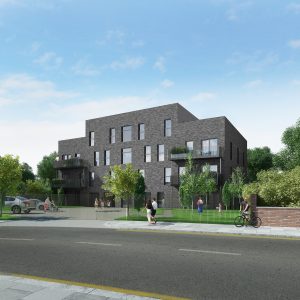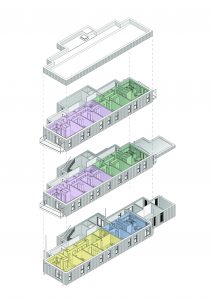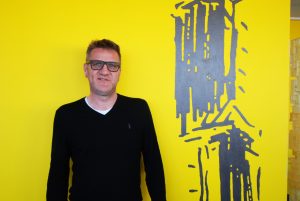Richard Hyams, director at astudio, explores how technology can help to improve the social and environmental impact for our built environment
 When the UK Government announced a £3bn green investment package in its summer statement, it renewed a commitment to a more sustainable future. And with the building and construction industry accounting for over 40% of global carbon emissions, reducing the carbon footprint and waste generation in construction must therefore remain a priority.
When the UK Government announced a £3bn green investment package in its summer statement, it renewed a commitment to a more sustainable future. And with the building and construction industry accounting for over 40% of global carbon emissions, reducing the carbon footprint and waste generation in construction must therefore remain a priority.
Creating buildings that help the UK to meet a net-zero carbon goal by 2050 is a challenge – not least as Covid-19 introduces new and evolving challenges. But technology and new innovations in materials and construction methods across the sector can provide solutions to this. Indeed, innovations are already arising to improve process efficiency, reduce carbon emissions and establish spaces suitable for today’s communities now and well beyond Covid-19.
A human-centric approach
While many of us think of sustainability as a low-energy, low-waste initiative, it is often much more than that. Living sustainably also requires community thinking, where supporting a local area can improve social cohesion and community resilience. That’s why architects are beginning to bring communities into the design process in new ways.
At the public consultation stage, many architects and developers are using Augmented and Virtual Reality to walk local communities through their designs, allowing them to visualise a finished space and recognise additional benefits to the area – including green spaces, pathway design and local retail opportunities.
Not only does this improve the outcome of consultation stages, it also improves community understanding of their space, enhancing their connection to their local environment and improving their sense of citizenship and belonging – all valuable to long-term sustainability.
Genetic algorithms
Of course, at the centre of sustainable construction is the industry itself and positively, technology is providing new ways for the sector to commit to its green goals. With decades of building data already available, creating AI algorithms that can replicate a traditional process and enhance it is just one way technology is helping. By identifying the best parameters for success, these AI algorithms can significantly reduce project timelines and waste.
Going further still, AI algorithms can now also combine traditional construction data with environmental factors, ‘suggesting’ the best solutions for energy efficiency such as window alignment and rooftop positioning for renewable energy sources, including solar and wind power which are increasingly being adopted. This technology also has the added commercial benefit of allowing project managers to visualise the most effective building design to enhance value.
Thinking outside the box
But delivering truly sustainable buildings goes beyond ensuring that the basic fabric of a building meets new energy efficiency guidelines. In fact, architects and designers are increasingly looking to the outside “skin” of their buildings.
For example, at astudio we have been developing algae façade technology that uses the efficient photosynthesis of algae and turns it into biofuel, allowing a building to act as its own energy fuel cell. This technology would benefit cities the most, where algae placed on a building’s façade can absorb CO2 to improve air pollution and, owing to its bioluminescent properties, even act as a source of light.
Design for Manufacture and offsite manufacturing’s role in improving the impact of construction
 Design for Manufacture and Assembly (DfMA) using offsite manufacturing techniques is a further innovation within the industry that can unite sustainability with social responsibility to develop a more efficient, less wasteful method of construction. And as offsite manufacturing and modular construction occurs under factory conditions, the margin for error is minimised, reducing construction waste and improving project efficiency.
Design for Manufacture and Assembly (DfMA) using offsite manufacturing techniques is a further innovation within the industry that can unite sustainability with social responsibility to develop a more efficient, less wasteful method of construction. And as offsite manufacturing and modular construction occurs under factory conditions, the margin for error is minimised, reducing construction waste and improving project efficiency.
By drawing on technology-powered tools such as 3D BIM models, the pace of delivery for these projects can be accelerated even further as if the designs are properly prepared, they can be linked directly to factory production. This significantly reduces the time spent translating the architect’s design into a manufactured set of drawings, creating a more seamless process for a more rapid build.
It is a method has proven incredibly valuable during the coronavirus crisis as it has allowed temporary structures to be erected and dissembled as and when they are needed, supporting communities and helping lessen the economic and social impact of Covid-19. Meanwhile, offsite manufacturing is also helping local councils tackle other societal ills, such as homelessness. Indeed, astudio has been working with High Wycombe Council to deliver 58 temporary modular homes for rough sleepers as well as helping Barking council deliver much needed affordable homes directly.
The future of construction is green
Achieving net-zero carbon emissions in a post-Covid world is not going to be an easy journey. However, there are exciting innovations out there, and indeed existing methods, that can be embraced so that we can deliver the future we need.
From technology at the design stages to changing a building’s facade to generate energy, and rolling out offsite construction, we have the tools and the ideas for a greener future in the years to come.

Richard Hyams
Director
Twitter: @AstudioArch
LinkedIn: astudio
















